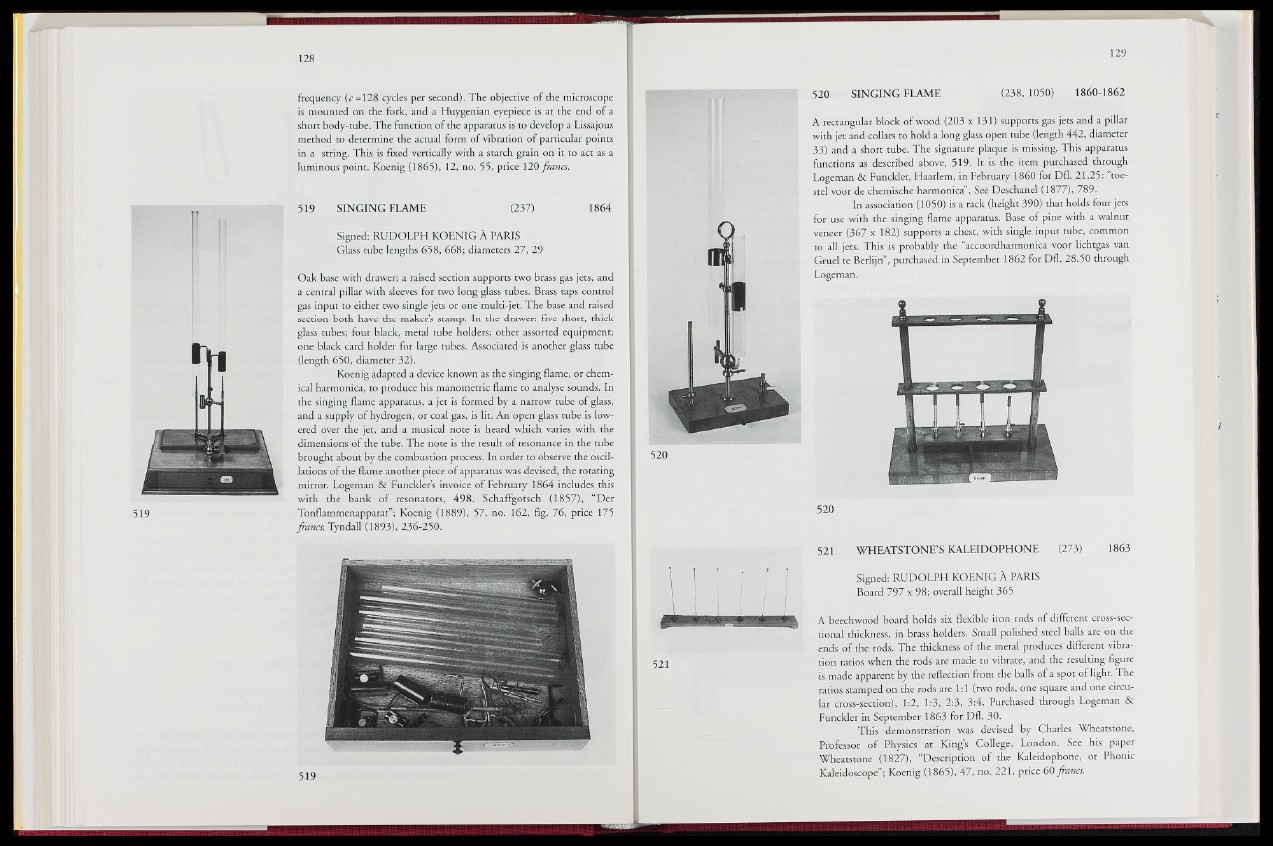
frequency (c =128 cycles per second). The objective of the microscope
is mounted on the fork, and a Huygenian eyepiece is at the end of a
short body-tube. The function of the apparatus is to develop a Lissajous
method to determine the actual form of vibration of particular points
in a string. This is fixed vertically with a starch grain on it to act as a
luminous point. Koenig (1865), 12, no. 55, price 120 francs.
519 SINGING FLAME (237) 1864
Signed: RUDOLPH KOENIG A PARIS
Glass tube lengths 658, 668; diameters 27, 29
Oak base with drawer; a raised section supports two brass gas jets, and
a central pillar with sleeves for two long glass tubes. Brass taps control
gas input to either two single jets or one multi-jet. The base and raised
section both have the makers stamp. In the drawer: five short, thick
glass tubes; four black, metal tube holders; other assorted equipment;
one black card holder for large tubes. Associated is another glass tube
(length 650, diameter 32).
Koenig adapted a device known as the singing flame, or chem-
i S i ■* ■ ical harmonica, to produce his manometric flame to analyse sounds. In
the singing flame apparatus, a jet is formed by a narrow tube of glass,
and a supply of hydrogen, or coal gas, is lit. An open glass tube is lowered
over the jet, and a musical note is heard which varies with the
dimensions of the tube. The note is the result of resonance in the tube
brought about by the combustion process. In order to observe the oscillations
of the flame another piece of apparatus was devised, the rotating
mirror. Logeman & Funckler’s invoice of February 1864 includes this
with the bank of resonators, 498. Schaffgotsch (185SIM “Per
519 Tonflammenapparat”; Koenig (1889), 57, no. 162, fig. 76, price 175
francs', Tyndall (1893), 236-250.
520 SINGING FLAME (238, 1050) 1860-1862
A rectangular block of wood (203 x 131) supports gas jets and a pillar
with jet and collars to hold a long glass open tube (length 442, diameter
33) and a short tube. The signature plaque is missing. This apparatus
functions as described above, 519. It is the item purchased through
Logeman 8C Funckler, Haarlem, in February 1860 for Dfl. 21.25: “toe-
stel voor de chemische harmonica”. See Deschanel (1877)V 789.
for use with the singing flame apparatus. Base of pine with a walnut
veneer (367 x 182) supports a chest, with single input tube, common
to all jets. This is probably the “accoordharmonica voor lichtgas van
Gruel te Berlijn”, purchased in September 1862 for Dfl. 28.50 through
Logeman.
520
In association (1050)!® a rack (height 390) that holds four jets
521 WHEATSTONE’S KALEIDOPHONE (273) 1863
Signed: RUDOLPH KOENIG A PARIS
Board 797 x 98; overall height 365
A beechwood board holds six flexible iron rods of different cross-sectional
thickness, in brass holders. Small polished steel balls are on the
ends of the rods. The thickness of the metal produces different vibration
ratios when the rods are made to vibrate, and the resulting figure
Is made apparent by the reflection from the balls of a spot of light. The
ratios stamped on the rods are 1:1 (two rods, one square and one circular
cross- section), 1:2, 1:3, 2:3, 3:4. Purchased through Logeman &
Funckler in September 1863 for Dfl. 30.
This demonstration was devised by Charles Wheatstone,
Professor- ofirPhysics at King’s College, London. See his paper
Wheatstone (1 8 i f |p “Description of the Kaleidophone, or Phonic
Kaleidoscope”; Koenig (1865), 47, no. 221, price 60 francs.